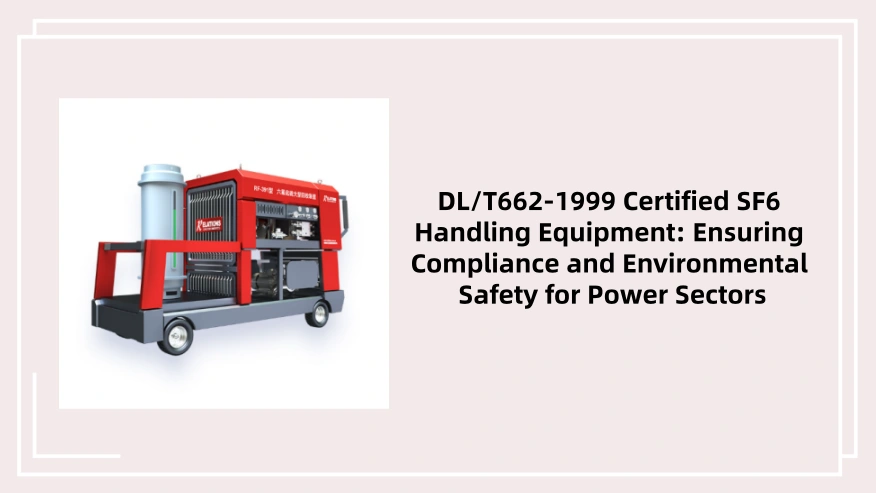
- SF6 Relations
- 2025-09-17
SF6 (sulfur hexafluoride) is widely used in the power industry for its excellent insulation and arc-extinguishing properties, making it a core medium for high-voltage equipment like circuit breakers and transformers. However, SF6 is a potent greenhouse gas with a global warming potential (GWP) 23,500 times that of CO₂, and its uncontrolled emission poses severe threats to the environment. To address this, China’s power industry established the DL/T662-1999 standard—officially titled Technical Specification for SF6 Gas Recovery, Purification and Filling Equipment—setting strict benchmarks for SF6 handling. DL/T662-1999 certified SF6 handling equipment has thus become a non-negotiable requirement for power enterprises seeking to balance operational safety, regulatory compliance, and environmental responsibility.
1. DL/T662-1999: The Cornerstone of Compliant SF6 Handling
Released by the China Electricity Council (CEC), DL/T662-1999 is a mandatory industry standard that defines technical parameters, performance requirements, and testing methods for SF6 handling equipment. Unlike generic SF6 tools, equipment certified to this standard undergoes rigorous verification to meet critical metrics:
- SF6 Recovery Rate: Requires a minimum recovery efficiency of 95% for used SF6 gas, minimizing waste and emission.
- Gas Purity Control: Ensures purified SF6 meets a purity level of ≥99.9%, enabling reuse in power equipment and avoiding performance degradation.
- Leakage Rate: Mandates a maximum leakage rate of ≤1×10⁻⁹ Pa·m³/s, far below global environmental thresholds to prevent accidental gas escape.
This standard not only aligns with China’s “dual carbon” (carbon peaking and carbon neutrality) goals but also harmonizes with international regulations like the Kyoto Protocol, making DL/T662-1999 certified SF6 handling equipment a global benchmark for sustainability.
2. Why DL/T662-1999 Certified SF6 Handling Equipment Is Indispensable
For power utilities, the risks of non-certified SF6 equipment extend beyond environmental penalties to operational failures:
- Environmental Compliance: Governments worldwide (including China’s Ministry of Ecology and Environment) have tightened SF6 emission controls. Using non-certified equipment can lead to fines of up to hundreds of thousands of yuan and damage to corporate reputation.
- Equipment Longevity: Impure SF6 (from non-certified purification) causes corrosion in high-voltage devices, shortening their lifespan by 30% or more. DL/T662-1999 certified equipment ensures gas quality, reducing maintenance costs and unplanned outages.
- Worker Safety: SF6 decomposition products (e.g., SO₂, HF) are toxic. Certified equipment includes built-in gas detection and ventilation systems, protecting personnel from exposure—a requirement not guaranteed by uncertified alternatives.
3. Core Functions of DL/T662-1999 Certified SF6 Handling Equipment
To meet DL/T662-1999’s strict criteria, certified equipment integrates four key functions:
- Efficient Recovery: Uses dual-stage compressors to extract SF6 from decommissioned or maintenance-bound equipment, achieving the 95% recovery rate mandate.
- Deep Purification: Employs multi-layer filters (molecular sieves, activated carbon) to remove moisture, oil, and impurities, restoring SF6 to reusable purity.
- Precise Filling: Features automated pressure and flow control to inject SF6 into equipment at optimal levels, avoiding overfilling (which causes leaks) or underfilling (which reduces insulation performance).
- Leak Detection: Equipped with ultrasonic or infrared sensors to identify micro-leaks during operation, aligning with the standard’s leakage rate requirement.
4. Key Considerations for Selecting DL/T662-1999 Certified SF6 Handling Equipment
Power enterprises must prioritize three factors when choosing certified equipment to maximize value:
- Authentic Certification: Verify that the manufacturer provides a valid DL/T662-1999 certification certificate issued by a CEC-accredited testing body (e.g., China Electric Power Research Institute). Avoid “self-certified” products, which often fail to meet standard requirements.
- Technical Matching: Select equipment with processing capacity (e.g., 50kg/h or 100kg/h) that aligns with the enterprise’s SF6 usage volume. For 500kV or ultra-high-voltage (UHV) equipment, choose models with enhanced pressure resistance (≥1.2MPa).
- After-Sales Support: Opt for manufacturers that offer regular calibration (required to maintain certification validity) and on-site maintenance. DL/T662-1999 mandates annual re-testing of equipment performance, so reliable after-sales service is critical.
5. The Dual Win: Compliance and Sustainability with Certified Equipment
In the context of global carbon reduction, DL/T662-1999 certified SF6 handling equipment is no longer just a regulatory requirement—it is a strategic asset. A 2024 industry report showed that power plants using certified equipment reduced SF6 emissions by 40% year-on-year and cut maintenance costs by 25%. For international power projects (e.g., Belt and Road Initiative collaborations), DL/T662-1999 certification also serves as a “green passport,” facilitating cross-border compliance.
DL/T662-1999 certified SF6 handling equipment bridges the gap between power sector operational needs and environmental stewardship. By adhering to this standard, power enterprises not only avoid regulatory risks but also contribute to global carbon reduction efforts while ensuring the reliability of high-voltage grids. As the industry moves toward cleaner energy, investing in DL/T662-1999 certified SF6 handling equipment is not just a choice—it is a necessity for long-term sustainability.
Leave a Reply